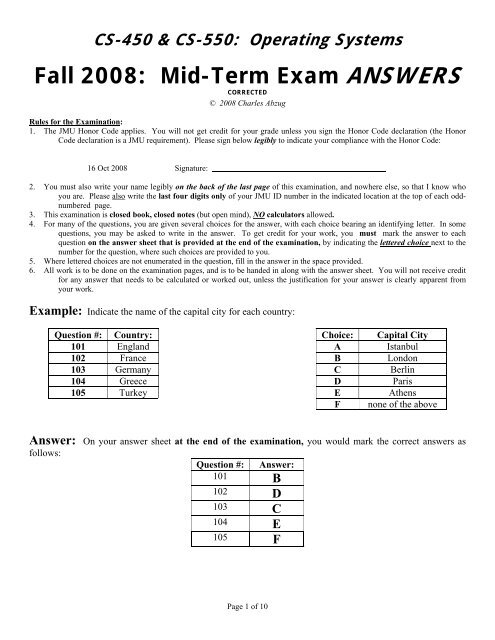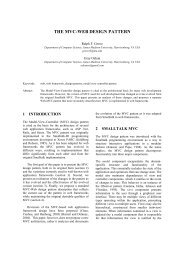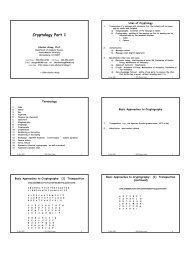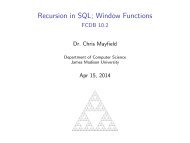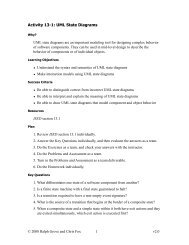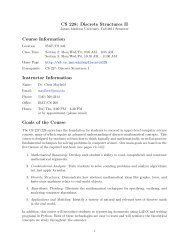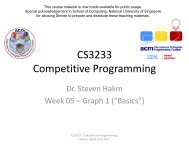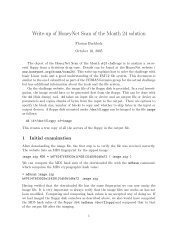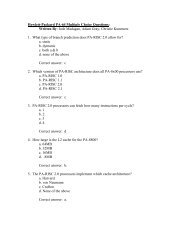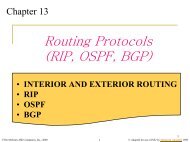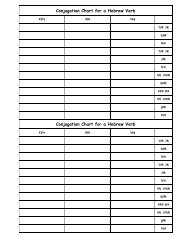A 2 pts - To Parent Directory
A 2 pts - To Parent Directory
A 2 pts - To Parent Directory
Create successful ePaper yourself
Turn your PDF publications into a flip-book with our unique Google optimized e-Paper software.
CS-450 & CS-550: Operating Systems<br />
Fall 2008: Mid-Term Exam ANSWERS<br />
CORRECTED<br />
© 2008 Charles Abzug<br />
Rules for the Examination:<br />
1. The JMU Honor Code applies. You will not get credit for your grade unless you sign the Honor Code declaration (the Honor<br />
Code declaration is a JMU requirement). Please sign below legibly to indicate your compliance with the Honor Code:<br />
16 Oct 2008 Signature: ___________________________________________<br />
2. You must also write your name legibly on the back of the last page of this examination, and nowhere else, so that I know who<br />
you are. Please also write the last four digits only of your JMU ID number in the indicated location at the top of each oddnumbered<br />
page.<br />
3. This examination is closed book, closed notes (but open mind), NO calculators allowed.<br />
4. For many of the questions, you are given several choices for the answer, with each choice bearing an identifying letter. In some<br />
questions, you may be asked to write in the answer. <strong>To</strong> get credit for your work, you must mark the answer to each<br />
question on the answer sheet that is provided at the end of the examination, by indicating the lettered choice next to the<br />
number for the question, where such choices are provided to you.<br />
5. Where lettered choices are not enumerated in the question, fill in the answer in the space provided.<br />
6. All work is to be done on the examination pages, and is to be handed in along with the answer sheet. You will not receive credit<br />
for any answer that needs to be calculated or worked out, unless the justification for your answer is clearly apparent from<br />
your work.<br />
Example: Indicate the name of the capital city for each country:<br />
Question #: Country: Choice: Capital City<br />
101 England A Istanbul<br />
102 France B London<br />
103 Germany C Berlin<br />
104 Greece D Paris<br />
105 Turkey E Athens<br />
F none of the above<br />
Answer: On your answer sheet at the end of the examination, you would mark the correct answers as<br />
follows:<br />
Question #: Answer:<br />
101 B<br />
102 D<br />
103 C<br />
104 E<br />
105 F<br />
Page 1 of 10
Item #i: The following statements all pertain to the Kernel of the Operating System. They are general statements, and you<br />
should consider their truth or falsity on the basis of whether or not they apply in general to all or nearly all Operating<br />
Systems, not just to one in particular. Mark each statement either T (true) or F (false):<br />
2 <strong>pts</strong> each<br />
1. The kernel implements all of the functionality of the Operating System. Answer: False<br />
2. All of the kernel of the Operating System must be continuously memory-resident. Answer: True<br />
3. The kernel of the Operating System includes the Interrupt Vector. Answer: True<br />
4. External Fragmentation and Internal Fragmentation of main memory can both be present simultaneously in a single computer<br />
system.<br />
Answer: False<br />
5. On a multi-user computer system, the Operating System is responsible for preventing a user from accessing the contents of<br />
system memory and of secondary storage allocated to other users.<br />
Answer: True<br />
6. In multi-threaded processing with Kernel-Level threads, the various threads associated with a single process must share a<br />
common Thread State (e.g., Ready, Blocked, or Running).<br />
Answer: False<br />
7. Part of the kernel is memory-resident, and part of it is not. Answer: False<br />
8. In all operating systems, a new program can be loaded into a child process’s Memory Address space at the instant of initial<br />
creation of the child process, different from the program in the parent’s Memory Address space, if it is desired that the<br />
child process execute a different program than the parent.<br />
Answer: False<br />
9. For Kernel-Level threads, when one thread associated with a particular process becomes blocked, then the entire process is<br />
blocked.<br />
Answer: False<br />
10. The kernel is the part of the Operating System that runs continuously. Answer: False<br />
11. A mid-term scheduler must be part of every Operating System other than those that execute a single-task-at-a-time.<br />
Answer: False<br />
12. In multi-threaded processing, the various threads associated with a single process share a common User Stack.<br />
Answer: False<br />
Item # ii: Indicate which of the following items are organized as separate processes (Yes or No):<br />
13. Several print jobs in the print SPOOLer. Answer: No<br />
14. The service routine for an interrupt. Answer: No<br />
15. Calls from within a single application program to several different subroutines. Answer: No<br />
16. Each different application program running on the system. Answer: Yes<br />
2 <strong>pts</strong> each<br />
Item # iii: Indicate which of the following are System Administration tasks (Yes or No):<br />
17. Addition of a new user. Answer: Yes<br />
18. Deletion of a user. Answer: Yes<br />
19. Installation of new application software. Answer: Yes<br />
20. Upgrading of existing application software. Answer: Yes<br />
21. Performance of secure backup. Answer: Yes<br />
2 <strong>pts</strong> each<br />
Item # iv: Which of the following are included in a process image (Yes or No):<br />
22. Executable program code. Answer: Yes<br />
23. The values of variables. Answer: Yes<br />
24. Copies of the contents of the various registers as of the last time the process ran on the CPU. Answer: No<br />
25. The user stack. Answer: Yes<br />
26. The Process Control Block (PCB). Answer: No<br />
2 <strong>pts</strong> each<br />
© 2008 Charles Abzug<br />
Page 2 of 10
Mid-Term Examination for Operating Systems<br />
Last four digits of your JMU ID Number: ___ ___ ___ ___<br />
Item # v: Consider the following direct process state transitions. By direct it is meant that a process can transition directly<br />
from the first state to the second without passing through any intermediate state. Indicate which of the direct state<br />
transitions listed can or cannot occur (Yes or No):<br />
2 <strong>pts</strong> each<br />
27. Running → Ready Answer: Yes<br />
28. Ready → Running Answer: Yes<br />
29. Ready → Blocked Answer: No<br />
30. Blocked → Ready Answer: Yes<br />
31. Running → Blocked Answer: Yes<br />
32. Blocked → Running Answer: No<br />
Item # vi: With regard to scheduling, indicate into which category of scheduling, if any, each of the activities listed below<br />
falls:<br />
2 <strong>pts</strong> each<br />
33. Dispatching of a Kernel-Level Thread to the CPU Answer: C<br />
34. Dispatching of a User-Level Thread to the CPU. Answer: C<br />
35. Dispatching of a process to the CPU. Answer: C<br />
36. Swapping of a process in to main memory from the disk or out of main memory to the disk. Answer: B<br />
37. Admission of a process to the system. Answer: A<br />
A. Long-Term Scheduling<br />
B. Mid-Term Scheduling<br />
C. Short-Term Scheduling<br />
D. all of the above.<br />
E. more than one, but not all, of the above.<br />
F. none of the above.<br />
Item vii: Indicate which statements are True, and which are False, regarding a single process and its threads:<br />
2 <strong>pts</strong> each<br />
38. In an operating system environment that operates with User-Level threads only (no Kernel-Level threads), the various threads<br />
associated with a single process all share a common context, including a common PC.<br />
Answer: False<br />
39. In an operating system environment that operates with Kernel-Level threads only (no User-Level threads), the various threads<br />
associated with a single process all share a common context, including a common PC.<br />
Answer: False<br />
40. The different threads associated with a single process all share a single processor context., i.e., the value of the Processor<br />
Status Word is the same for all such threads.<br />
Answer: False<br />
41. Thread creation takes more time than process creation. Answer: False<br />
42. Each thread associated with a single process has exclusive ownership of any files that it has opened; they are not available to<br />
other threads associated with the same process.<br />
Answer: False<br />
43. Each thread associated with a single process has a separate text (program code) area. Answer: False<br />
© 2008 Charles Abzug<br />
Page 3 of 10
Item viii: A Preemptive job scheduler is invoked when (Yes or No):<br />
44. the currently running process finishes execution and terminates. Answer: Yes<br />
45. the currently running process issues a blocking system call. Answer: Yes<br />
46. another process’s I/O completes, moving that process to the ready queue. Answer: Yes<br />
47. a Timer Interrupt occurs: time quantum exceeded. Answer: Yes<br />
2 <strong>pts</strong> each<br />
Item ix: Consider the following page reference stream:<br />
0, 3, 1, 4, 1,5, 1, 6, 0, 5, 2, 6, 7, 5, 0, 0, 0, 6, 6, 6, 6, 3, 2, 4, 3, 4<br />
For a page frame allocation of 4, and assuming that the primary memory is initially unloaded, determine how many<br />
page faults will this page reference stream incur under:<br />
48. . Belady’s Optimal Algorithm.<br />
49. the First-In-First-Out (FIFO) algorithm.<br />
50. the Least Recently Used (LRU) algorithm.<br />
12 <strong>pts</strong> each<br />
OPTIMAL ALGORITHM<br />
Page<br />
Referenced<br />
0 3 1 4 1 5 1 6 0 5 2 6 7 5 0 0 0 6 6 6 6 3 2 4 3 4<br />
Page Fault F F F F N F N F N N F N F N N N N N N N N F F F N N<br />
Page Frame 1 0 0 0 0 0 0 0 0 0 0 0 0 0 0 0 0 0 0 0 0 0 3 3 3 3 3<br />
Page Frame 2 3 3 3 3 3 3 3 3 3 2 2 7 7 7 7 7 7 7 7 7 7 7 7 7 7<br />
Page Frame 3 1 1 1 1 1 6 6 6 6 6 6 6 6 6 6 6 6 6 6 6 6 4 4 4<br />
Page Frame 4 4 4 5 5 5 5 5 5 5 5 5 5 5 5 5 5 5 5 5 2 2 2 2<br />
Answer: 11 page faults (4 + 7)<br />
First-In-First-Out (FIFO) ALGORITHM<br />
Page<br />
Referenced<br />
0 3 1 4 1 5 1 6 0 5 2 6 7 5 0 0 0 6 6 6 6 3 2 4 3 4<br />
Page Fault F F F F N F N F F N F N F F N N N F N N N F F F N N<br />
Page Frame 1 0 0 0 0 0 5 5 5 5 5 5 5 7 7 7 7 7 7 7 7 7 7 2 2 2 2<br />
Page Frame 2 3 3 3 3 3 3 6 6 6 6 6 6 5 5 5 5 5 5 5 5 5 5 4 4 4<br />
Page Frame 3 1 1 1 1 1 1 0 0 0 0 0 0 0 0 0 6 6 6 6 6 6 6 6 6<br />
Page Frame 4 4 4 4 4 4 4 4 2 2 2 2 2 2 2 2 2 2 2 3 3 3 3 3<br />
Answer: 14 page faults (4 + 10)<br />
© 2008 Charles Abzug<br />
Page 4 of 10
Mid-Term Examination for Operating Systems<br />
Last four digits of your JMU ID Number: ___ ___ ___ ___<br />
Least-Recently-Used (LRU) ALGORITHM<br />
Page<br />
Referenced<br />
0 3 1 4 1 5 1 6 0 5 2 6 7 5 0 0 0 6 6 6 6 3 2 4 3 4<br />
Page Fault F F F F N F N F F N F N F N F N N N N N N F F F N N<br />
Page Frame 1 0 0 0 0 0 5 5 5 5 5 5 5 5 5 5 5 5 5 5 5 5 5 2 2 2 2<br />
Page Frame 2 3 3 3 3 3 3 6 6 6 6 6 6 6 6 6 6 6 6 6 6 6 6 6 6 6<br />
Page Frame 3 1 1 1 1 1 1 1 1 2 2 2 2 0 0 0 0 0 0 0 0 0 4 4 4<br />
Page Frame 4 4 4 4 4 4 0 0 0 0 7 7 7 7 7 7 7 7 7 3 3 3 3 3<br />
Answer: 13 page faults (4 + 9)<br />
Item x: Several processes enter the ready queue in the order shown. Each I/O takes 20 msec, and I/Os are executed on a<br />
separate, dedicated device for each process, so that the I/Os for different processes can run simultaneously. Context<br />
switching takes less than 100 μsec, and can therefore be ignored. Lower priority numbers correspond to higher<br />
process priority. Assume that the CPU Burst Time for each process is identical from one burst to the next:<br />
Time of<br />
Arrival<br />
Process<br />
ID<br />
CPU Burst<br />
Time (msec)<br />
0.0 msec P1 14 3<br />
1.0 msec P2 7 7<br />
2.0 msec P3 27 2<br />
3.0 msec P4 4 3<br />
4.0 msec P5 10 1<br />
Process Priority (useful only with<br />
regard to Priority Scheduling)<br />
For each processor-scheduling algorithm indicated, determine which process does the scheduler assign to the processor for the sixth<br />
scheduling decision, and also at what time is that scheduling decision made.<br />
8 <strong>pts</strong> each<br />
Algorithm<br />
Process<br />
Start<br />
Time<br />
Shortest Remaining Time Next 51. 52.<br />
Round Robin (time quantum = 12 msec) 53. 54.<br />
Priority Scheduling without preemption (simple priority: NO<br />
aging, NO adjustments of any kind in process priority)<br />
55. 56.<br />
© 2008 Charles Abzug<br />
Page 5 of 10
Scheduling Algorithm (qualifier): Shortest Remaining Time Next<br />
Time: 0 msec. Process P1 runs. Time: 1 msec. Process P2 runs.<br />
READY Queue WAIT Queue READY Queue WAIT Queue<br />
Element PID RBT Element trrq PID Element PID RBT Element trrq PID<br />
First: P1 14 First: First: P2 7 First:<br />
Second: Second: Second: P1 13 Second:<br />
Third: Third: Third: Third:<br />
Fourth: Fourth: Fourth: Fourth:<br />
Fifth: Fifth: Fifth: Fifth:<br />
Time: 2 msec. Process P2 runs. Time: 3 msec. Process P4 runs.<br />
READY Queue WAIT Queue READY Queue WAIT Queue<br />
Element PID RBT Element trrq PID Element PID RBT Element trrq PID<br />
First: P1 13 First: First: P1 13 First:<br />
Second: P3 27 Second: Second: P3 27 Second:<br />
Third: P2 6 Third: Third: P4 4 Third:<br />
Fourth: Fourth: Fourth: P2 5 Fourth:<br />
Fifth: Fifth: Fifth: Fifth:<br />
Time: 4 msec. Process P4 runs. Time: 7 msec. Process P2 runs.<br />
READY Queue WAIT Queue READY Queue WAIT Queue<br />
Element PID RBT Element trrq PID Element PID RBT Element trrq PID<br />
First: P1 13 First: First: P1 13 First: 27 P4<br />
Second: P3 27 Second: Second: P3 27 Second:<br />
Third: P2 5 Third: Third: P2 5 Third:<br />
Fourth: P5 10 Fourth: Fourth: P5 10 Fourth:<br />
Fifth: P4 3 Fifth: Fifth: Fifth:<br />
Time: msec. Process runs. Time: msec. Process runs.<br />
READY Queue WAIT Queue READY Queue WAIT Queue<br />
Element PID RBT Element trrq PID Element PID RBT Element trrq PID<br />
First: First: First: First:<br />
Second: Second: Second: Second:<br />
Third: Third: Third: Third:<br />
Fourth: Fourth: Fourth: Fourth:<br />
Fifth: Fifth: Fifth: Fifth:<br />
Answer: Process P2 is selected to run at 7 msec.<br />
© 2008 Charles Abzug<br />
Page 6 of 10
Mid-Term Examination for Operating Systems<br />
Last four digits of your JMU ID Number: ___ ___ ___ ___<br />
Scheduling Algorithm (qualifier): Round Robin (quantum = 12 msec)<br />
Time: 0 msec. Process P1 runs. Time: 12 msec. Process P2 runs.<br />
READY Queue WAIT Queue READY Queue WAIT Queue<br />
Element PID RBT Element trrq PID Element PID RBT Element trrq PID<br />
First: P1 14 First: First: P2 7 First:<br />
Second: Second: Second: P3 27 Second:<br />
Third: Third: Third: P4 4 Third:<br />
Fourth: Fourth: Fourth: P5 10 Fourth:<br />
Fifth: Fifth: Fifth: P1 2 Fifth:<br />
Time: 19 msec. Process P3 runs. Time: 31 msec. Process P4 runs.<br />
READY Queue WAIT Queue READY Queue WAIT Queue<br />
Element PID RBT Element trrq PID Element PID RBT Element trrq PID<br />
First: P3 27 First: 39 P2 First: P4 4 First: 39 P2<br />
Second: P4 4 Second: Second: P5 10 Second:<br />
Third: P5 10 Third: Third: P1 2 Third:<br />
Fourth: P1 2 Fourth: Fourth: P3 15 Fourth:<br />
Fifth: Fifth: Fifth: Fifth:<br />
Time: 35 msec. Process P5 runs. Time: 45 msec. Process P1 runs.<br />
READY Queue WAIT Queue READY Queue WAIT Queue<br />
Element PID RBT Element trrq PID Element PID RBT Element trrq PID<br />
First: P5 10 First: 39 P2 First: P1 2 First: 55 P4<br />
Second: P1 2 Second: 55 P4 Second: P2 7 Second: 65 P5<br />
Third: P3 15 Third: Third: P3 15 Third:<br />
Fourth: Fourth: Fourth: Fourth:<br />
Fifth: Fifth: Fifth: Fifth:<br />
Time: msec. Process runs. Time: msec. Process runs.<br />
READY Queue WAIT Queue READY Queue WAIT Queue<br />
Element PID RBT Element trrq PID Element PID RBT Element trrq PID<br />
First: First: First: First:<br />
Second: Second: Second: Second:<br />
Third: Third: Third: Third:<br />
Fourth: Fourth: Fourth: Fourth:<br />
Fifth: Fifth: Fifth: Fifth:<br />
Answer: Process P1 is selected to run at 45 msec.<br />
© 2008 Charles Abzug<br />
Page 7 of 10
Scheduling Algorithm (qualifier): Priority Scheduling without Preemption<br />
Time: 0 msec. Process P1 runs. Time: 14 msec. Process P5 runs.<br />
READY Queue WAIT Queue READY Queue WAIT Queue<br />
Element PID RBT Element trrq PID Element PID RBT Element trrq PID<br />
First: P1 14 First: First: P2 7 First: 34 P1<br />
Second: Second: Second: P3 27 Second:<br />
Third: Third: Third: P4 4 Third:<br />
Fourth: Fourth: Fourth: P5 10 Fourth:<br />
Fifth: Fifth: Fifth: Fifth:<br />
Time: 24 msec. Process P3 runs. Time: 51 msec. Process P5 runs.<br />
READY Queue WAIT Queue READY Queue WAIT Queue<br />
Element PID RBT Element trrq PID Element PID RBT Element trrq PID<br />
First: P2 7 First: 34 P1 First: P2 7 First: 71 P3<br />
Second: P3 27 Second: 44 P5 Second: P4 4 Second:<br />
Third: P4 4 Third: Third: P1 14 Third:<br />
Fourth: Fourth: Fourth: P5 10 Fourth:<br />
Fifth: Fifth: Fifth: Fifth:<br />
Time: 61 msec. Process P4 runs. Time: 65 msec. Process P1 runs.<br />
READY Queue WAIT Queue READY Queue WAIT Queue<br />
Element PID RBT Element trrq PID Element PID RBT Element trrq PID<br />
First: P2 7 First: 71 P3 First: P2 7 First: 71 P3<br />
Second: P4 4 Second: 81 P5 Second: P1 14 Second: 81 P5<br />
Third: P1 14 Third: Third: Third: 85 P4<br />
Fourth: Fourth: Fourth: Fourth:<br />
Fifth: Fifth: Fifth: Fifth:<br />
Time: msec. Process runs. Time: msec. Process runs.<br />
READY Queue WAIT Queue READY Queue WAIT Queue<br />
Element PID RBT Element trrq PID Element PID RBT Element trrq PID<br />
First: First: First: First:<br />
Second: Second: Second: Second:<br />
Third: Third: Third: Third:<br />
Fourth: Fourth: Fourth: Fourth:<br />
Fifth: Fifth: Fifth: Fifth:<br />
Answer: Process P1 is selected at 65 msec.<br />
© 2008 Charles Abzug<br />
Page 8 of 10
Mid-Term Examination for Operating Systems<br />
Last four digits of your JMU ID Number: ___ ___ ___ ___<br />
Item xi: Consider the following sequence of Linux commands, and the indicated response shown to each. Each typed command<br />
is shown in bold, and the responses in plain typeface.<br />
$ ls<br />
demo names temp<br />
$ mkdir /home/alex/literature<br />
$ ls<br />
demo literature names temp<br />
NOTE: From the two directory listings, we can conclude that the current working directory is<br />
“/home/alex”<br />
$ ln names /home/alex/literature/newNamesOne<br />
NOTE: This command results in the existence of two directory listings pointing to the inode of<br />
a single file. If the file is accessed via either one of the directory listings and is modified, then the<br />
changes will be seen by anyone accessing the file either from the same directory listing or the<br />
other directory listing.<br />
$ cp temp /home/alex/literature/tempTwo<br />
NOTE: This command creates a new file named “tempTwo” in the directory<br />
“/home/alex/literature”. The new file is an exact copy of the file “temp” that had previously been<br />
present in “/home/alex”. Since there are now two complete copies of the file, each file, “temp”<br />
and “tempTwo”, can be modified without affecting the content of the other file.<br />
$ rm names<br />
NOTE: This command deletes the entry “names” from the directory /home/alex.<br />
However, the file remains on the disk and can still be accessed through the hard link<br />
newNamesOne that had previously been created in the directory /home/alex/literature<br />
$ cd /home/alex/literature<br />
$ ls<br />
57. What response is obtained to the last command<br />
Answer:<br />
E<br />
A. demo names temp<br />
B. demo literature names temp<br />
C. newNamesOne temp tempTwo<br />
D. newNamesOne temp<br />
E. newNamesOne tempTwo<br />
F. none of the above.<br />
5 <strong>pts</strong><br />
Item xii: If you had made this assignment: $ furniture=table indicate the output of each command.<br />
58. $ echo $furniture Answer: table<br />
59. $ echo ‘$furniture’ Answer: $furniture<br />
60. $ echo “furniture” Answer: furniture<br />
Item xiii: If an i-node contains ten direct addresses of 4 bytes each, and all disk blocks are 1024 kB,<br />
61. what is the largest possible file<br />
2 <strong>pts</strong> each<br />
10 <strong>pts</strong><br />
Answer: 10,240 kB or 10.24 MB<br />
© 2008 Charles Abzug<br />
Page 9 of 10
Fall 2008 Mid-Term: CS-450 & CS-550<br />
Ques- Answer: Question:<br />
Answer: Ques- Answer:<br />
tion:<br />
tion:<br />
1 F 2 <strong>pts</strong> 26 N 2 <strong>pts</strong> 51 P2 8 <strong>pts</strong><br />
2 T 2 <strong>pts</strong> 27 Y 2 <strong>pts</strong> 52 7 msec 8 <strong>pts</strong><br />
3 T 2 <strong>pts</strong> 28 Y 2 <strong>pts</strong> 53 P1 8 <strong>pts</strong><br />
4 F 2 <strong>pts</strong> 29 N 2 <strong>pts</strong> 54 45 msec8 <strong>pts</strong><br />
5 T 2 <strong>pts</strong> 30 Y 2 <strong>pts</strong> 55 P1 8 <strong>pts</strong><br />
6 F 2 <strong>pts</strong> 31 Y 2 <strong>pts</strong> 56 65 msec8 <strong>pts</strong><br />
7 F 2 <strong>pts</strong> 32 N 2 <strong>pts</strong> 57 E 5 <strong>pts</strong><br />
8 F 2 <strong>pts</strong> 33 C 2 <strong>pts</strong> 58 table<br />
2 <strong>pts</strong><br />
9 F 2 <strong>pts</strong> 34 C 2 <strong>pts</strong> 59 $furniture<br />
2 <strong>pts</strong><br />
10 F 2 <strong>pts</strong> 35 C 2 <strong>pts</strong> 60 furniture<br />
2 <strong>pts</strong><br />
11 F 2 <strong>pts</strong> 36 B 2 <strong>pts</strong> 61 10.24 MB<br />
10 <strong>pts</strong><br />
12 F 2 <strong>pts</strong> 37 A 2 <strong>pts</strong><br />
13 N 2 <strong>pts</strong> 38 F 2 <strong>pts</strong><br />
14 N 2 <strong>pts</strong> 39 F 2 <strong>pts</strong><br />
15 N 2 <strong>pts</strong> 40 F 2 <strong>pts</strong><br />
16 Y 2 <strong>pts</strong> 41 F 2 <strong>pts</strong><br />
17 Y 2 <strong>pts</strong> 42 F 2 <strong>pts</strong><br />
18 Y 2 <strong>pts</strong> 43 F 2 <strong>pts</strong><br />
19 Y 2 <strong>pts</strong> 44 Y 2 <strong>pts</strong><br />
20 Y 2 <strong>pts</strong> 45 Y 2 <strong>pts</strong><br />
21 Y 2 <strong>pts</strong> 46 Y 2 <strong>pts</strong><br />
22 Y 2 <strong>pts</strong> 47 Y 2 <strong>pts</strong><br />
23 Y 2 <strong>pts</strong> 48 11 12 <strong>pts</strong><br />
24 N 2 <strong>pts</strong> 49 14 12 <strong>pts</strong><br />
25 Y 2 <strong>pts</strong> 50 13 12 <strong>pts</strong><br />
© 2008 Charles Abzug<br />
Page 10 of 10


